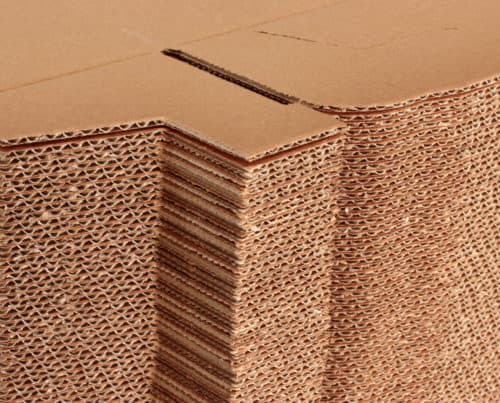What is Corrugated Cardboard?

With the uptick of online shopping, it’s nearly impossible to go through one day without seeing the iconic brown shipping box. The shipping box material is often referred to colloquially as cardboard, though it’s a misnomer. But what is corrugated cardboard?
First, we should point out that cardboard is an incorrect term for shipping boxes. In the 16th century, cardboard was also referred to as cardpaper, which seems a better word for its definition. In simplest terms, cardboard is a stiff paper or pasteboard, sometimes called paperboard.
Cardboard is used to make folding cartons, which are used as primary packaging for many retail goods. These boxes are not suitable for shipping as they offer little protection. If you look at the edge of a piece of cardboard and compare it to the edge of a piece of a shipping box, you will see a stark difference.
Cardboard is a single, thick layer, whereas the shipping box material comprises three or more layers with a fluted center. The fluted center, called medium, gives corrugated board its name. Merriam Webster defines corrugate: to form or shape into alternating ridges and grooves. So technically speaking, corrugated cardboard is fluted pasteboard.
What Are Shipping Boxes Made From If Not Corrugated Cardboard?
The correct term for the material used for shipping boxes is not corrugated cardboard but corrugated board. The boxes are simply called corrugated boxes.
As previously explained, corrugated board is made of several layers glued together. The outer layer is called linerboard. The fluted medium is sandwiched between sheets of liner board to create single-wall corrugated board. Other combinations include:
Single-face — This has only one sheet of liner board and one corrugated medium glued together with flutes exposed. This is often wrapped around products or a filler in boxes to offer additional protection.
Double-wall — This combines a single-wall board with a single-face. This 5-ply construction contains three sheets of liner board interleaved with two sheets of corrugated medium.
Triple-wall — This combines another layer of single-face to double-wall, creating four sheets of linerboard interleaved with three sheets of corrugated medium.
The more layers, the stronger the corrugated board, so double-wall and triple-wall are typically used for shipping very heavy items or bulk materials.
The medium not only adds cushioning but can contribute to the box strength according to its flute profile. Flute profiles differ by the height and width of the flute and serve different functions. There are five common flute types: A, B, C, E, F. The letter designation was assigned based on the order created and does not indicate the flute’s strength or cushioning properties.
C-flute’s most widely used because it offers good crushing resistance, stacking strength, and printing properties. Double-wall and triple wall corrugated boards may use more than one flute profile, depending on the need.
How are Corrugated Boxes Made?
There are several steps required to get from forest trees to corrugated boards.
Paper-Mill – A papermill makes rolls of kraft linerboard from sustainably harvested trees. The wood is turned into wood pulp that is processed into a slurry, often with a percentage of recycled corrugated board fibers, using mechanical and chemical processes. It may be bleached if white kraft linerboard is being made. The slurry is refined, washed, and formed into kraft linerboard through pressurized rollers.
Corrugating machine – The rolls are sent to a corrugating facility where a corrugating machine, using high-pressure steam and starch-based adhesive, shapes the kraft paper into flutes to create the medium.
Single-facer glue station – The tips of the flutes receive a starch-based adhesive before being attached to the first linerboard to form a single-faced web. The adhesive is cured using heat, pressure, and steam, forming a strong bond between the layers.
Double-backer or Double-facer station – A double-faced corrugated sheet is created by attaching a second linerboard. The glue is cured and moisture is removed by passing the board over hot plates.
Two single-faced webs are combined at the double glue unit if a double-wall board is being made.
Once the layers of linerboard and medium are adhered together, the resulting corrugated board may also be referred to as combined board. The board must now be cut into a box blank and have the edge glued, sewn, or taped to create the box that will be assembled.
The corrugated board may be cut by a combination machine that will cut, score, glue, and print the box using a single machine, or multiple steps may be involved. Instead of gluing, some boxes require stitching or taping, which another machine would do. The resulting folded, printed box is referred to as a knock-down (KD) box. These are stacked, banded or wrapped, and shipped to the customer for use.
Learn the difference between sheet feeders, corrugated plants, and sheet plants by reading, Is Your Corrugated Supplier the Right Type For Your Needs?
How is Box Blank Shape Determined?
The box size and shape should be determined based on a number of factors, including product size and weight, shipping method, environmental conditions, pallet requirements, how products are packed, and more. Sometimes the box blank is just a standard size offered by the manufacturer. The problem with standard boxes is that they can cost you more in the long run.
A packaging assessment can help ensure you don’t miss an essential element. You will find there are many benefits to using packaging designed specifically for your product.
To read more about the benefits of using corrugated for shipping products, see Four Corrugated Advantages That Can Add to Your Bottom Line.
Consider Axis for Your Corrugated Boxes
If you are interested in learning more about how Axis manufacturers corrugated boxes and all the options available, contact us. When we manufacturer your boxes, we will optimize them to protect your product, reduce material use, minimize wasteful fill-voids, and reduce DIM factors, ultimately helping you reduce costs.
